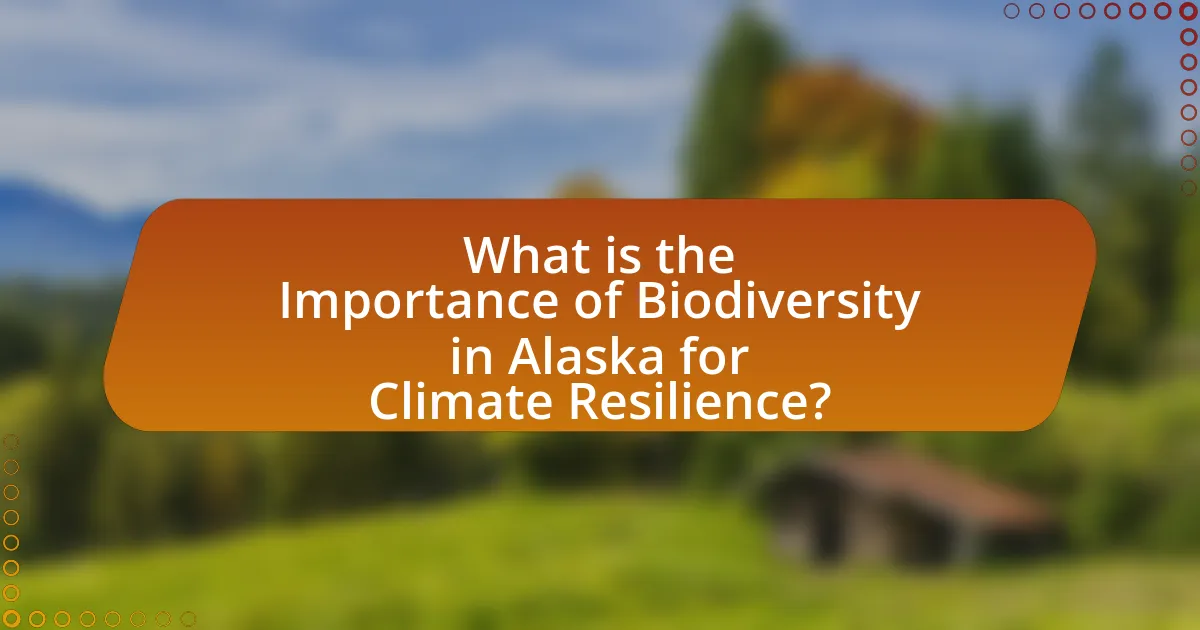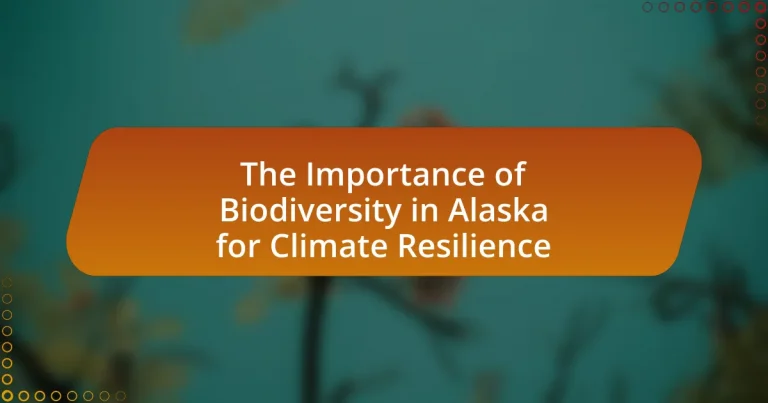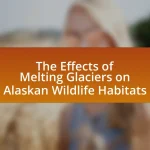Biodiversity in Alaska plays a critical role in enhancing climate resilience by promoting ecosystem stability and adaptability to environmental changes. The article examines how diverse species contribute to essential ecosystem services, such as carbon sequestration and nutrient cycling, which are vital for maintaining ecological health. It highlights specific ecosystems, including tundra, boreal forests, and coastal wetlands, that support unique species and contribute to Alaska’s rich biodiversity. Additionally, the article discusses the impacts of climate change on these ecosystems, the economic benefits of preserving biodiversity, and the importance of conservation strategies and community involvement in protecting Alaska’s natural resources.

What is the Importance of Biodiversity in Alaska for Climate Resilience?
Biodiversity in Alaska is crucial for climate resilience as it enhances ecosystem stability and adaptability to changing environmental conditions. Diverse species contribute to a range of ecosystem services, such as carbon sequestration, which mitigates climate change impacts. For instance, healthy forests and wetlands in Alaska store significant amounts of carbon, helping to regulate atmospheric CO2 levels. Additionally, biodiversity supports food webs and nutrient cycling, which are essential for maintaining ecosystem health. Research indicates that ecosystems with higher biodiversity are more resilient to disturbances, such as extreme weather events, which are becoming more frequent due to climate change. Thus, preserving Alaska’s biodiversity is vital for sustaining its ecosystems and enhancing their ability to cope with climate variability.
How does biodiversity contribute to climate resilience in Alaska?
Biodiversity contributes to climate resilience in Alaska by enhancing ecosystem stability and adaptability. Diverse species and genetic variations within ecosystems allow for better responses to environmental changes, such as temperature fluctuations and extreme weather events. For instance, a study by the Alaska Climate Adaptation Science Center highlights that ecosystems with higher biodiversity can recover more quickly from disturbances, thereby maintaining essential services like carbon storage and water filtration. This resilience is crucial in Alaska, where climate change impacts are pronounced, including permafrost thawing and habitat shifts.
What specific ecosystems in Alaska are vital for maintaining biodiversity?
The specific ecosystems in Alaska that are vital for maintaining biodiversity include tundra, boreal forests, coastal wetlands, and marine ecosystems. Tundra ecosystems, characterized by low temperatures and permafrost, support unique flora and fauna adapted to harsh conditions, contributing to overall biodiversity. Boreal forests, which cover a significant portion of Alaska, provide habitat for various species, including moose and bears, and play a crucial role in carbon storage. Coastal wetlands serve as critical breeding and feeding grounds for migratory birds and fish, enhancing ecological diversity. Marine ecosystems, particularly the rich waters of the Bering Sea, support diverse marine life, including seals, sea lions, and numerous fish species, which are essential for both ecological balance and local economies. These ecosystems collectively contribute to Alaska’s rich biodiversity, which is essential for climate resilience and ecological stability.
How do various species interact to enhance ecosystem stability?
Various species interact to enhance ecosystem stability through mutualism, competition, and predation, which collectively maintain balance and resilience. For instance, mutualistic relationships, such as those between pollinators and flowering plants, ensure reproductive success and genetic diversity, crucial for adapting to environmental changes. Additionally, competition for resources among species can lead to niche differentiation, allowing multiple species to coexist and utilize different resources, thereby reducing the risk of ecosystem collapse. Predation regulates population sizes, preventing any single species from dominating and ensuring a diverse community structure. Research indicates that ecosystems with higher biodiversity are more resilient to disturbances, as diverse species can fulfill various ecological roles, contributing to overall stability.
Why is Alaska’s biodiversity unique compared to other regions?
Alaska’s biodiversity is unique due to its vast range of ecosystems, including tundra, boreal forests, and coastal habitats, which support a high number of endemic species. The state’s geographical isolation and extreme climatic conditions have led to the evolution of species that are not found elsewhere, such as the Alexander Archipelago wolf and the Steller’s eider. Additionally, Alaska’s biodiversity plays a crucial role in climate resilience, as diverse ecosystems can better withstand environmental changes and support a variety of wildlife, contributing to overall ecological stability.
What factors contribute to the high levels of biodiversity in Alaska?
The high levels of biodiversity in Alaska are primarily attributed to its diverse ecosystems, varying climates, and geographical features. Alaska’s vast range of habitats, including tundra, forests, wetlands, and coastal areas, supports a wide array of plant and animal species. The state’s location along the Pacific Flyway also facilitates migratory patterns, enhancing species diversity. Additionally, the presence of both marine and terrestrial environments allows for unique interactions among species. Research indicates that Alaska is home to over 1,700 species of vascular plants and numerous wildlife species, including 400 bird species and 200 mammal species, underscoring its rich biodiversity.
How does the geographical diversity of Alaska influence its ecosystems?
The geographical diversity of Alaska significantly influences its ecosystems by creating a wide range of habitats that support various species. This diversity includes mountains, tundra, forests, and coastal areas, each providing unique environmental conditions. For instance, the coastal regions are rich in marine life due to nutrient upwelling, while the tundra supports specialized flora and fauna adapted to extreme cold. The variation in elevation and climate across Alaska leads to distinct ecological zones, which in turn fosters high biodiversity. According to the U.S. Fish and Wildlife Service, Alaska is home to over 500 species of birds and numerous mammals, illustrating how geographical features contribute to ecological richness.
What are the potential impacts of climate change on Alaska’s biodiversity?
Climate change poses significant threats to Alaska’s biodiversity, leading to habitat loss, altered species distributions, and increased extinction risks. As temperatures rise, ecosystems such as tundra and boreal forests are shifting, which disrupts the habitats of native species. For instance, warmer temperatures have been linked to the northward migration of species like the moose, while polar bears face diminishing sea ice, crucial for their hunting and breeding. Additionally, increased frequency of wildfires and changing precipitation patterns further threaten plant and animal species, reducing biodiversity and ecosystem resilience. Studies indicate that these changes could lead to a loss of up to 50% of species in some areas by the end of the century if current trends continue.
How might changing temperatures affect species distribution in Alaska?
Changing temperatures in Alaska are likely to shift species distribution northward and to higher elevations. As temperatures rise, many species, particularly those sensitive to climate, may migrate to cooler areas to survive, leading to altered ecosystems. For instance, studies indicate that plant and animal species are already moving northward at a rate of approximately 15 kilometers per decade due to warming temperatures. This shift can disrupt existing food webs and lead to increased competition among species, ultimately affecting biodiversity and ecosystem stability in Alaska.
What role does biodiversity play in mitigating the effects of climate change?
Biodiversity plays a crucial role in mitigating the effects of climate change by enhancing ecosystem resilience and stability. Diverse ecosystems, such as those found in Alaska, can better withstand and adapt to climate-related stresses, including temperature fluctuations and extreme weather events. For instance, a study published in the journal “Nature” indicates that ecosystems with higher species diversity are more productive and can sequester more carbon, thus reducing greenhouse gas concentrations in the atmosphere. Additionally, diverse plant species contribute to soil health and water retention, further supporting climate resilience.
How can we protect and enhance biodiversity in Alaska?
To protect and enhance biodiversity in Alaska, implementing conservation strategies such as habitat restoration, sustainable land management, and species protection is essential. Habitat restoration efforts, like reforestation and wetland rehabilitation, can improve ecosystems that support diverse species. Sustainable land management practices, including controlled development and responsible resource extraction, help minimize habitat destruction. Additionally, protecting endangered species through legal frameworks and conservation programs ensures the survival of vulnerable populations. According to the Alaska Department of Fish and Game, these strategies are crucial for maintaining the ecological balance and resilience of Alaska’s unique biodiversity, which is vital for climate adaptation and overall environmental health.
What conservation strategies are currently in place in Alaska?
Alaska employs several conservation strategies to protect its unique biodiversity and enhance climate resilience. These strategies include the establishment of protected areas, such as national parks and wildlife refuges, which cover approximately 60% of the state’s land. Additionally, Alaska implements habitat restoration projects aimed at reversing the impacts of climate change and human activity on ecosystems. The state also engages in collaborative management practices involving Indigenous communities, ensuring traditional ecological knowledge informs conservation efforts. Furthermore, Alaska participates in international agreements, such as the Arctic Council, to address transboundary environmental issues. These strategies collectively aim to preserve biodiversity, which is crucial for maintaining ecosystem functions and resilience against climate change impacts.
How can local communities contribute to biodiversity conservation?
Local communities can contribute to biodiversity conservation by engaging in sustainable land management practices and participating in local conservation initiatives. These practices include habitat restoration, responsible resource use, and the protection of native species. For example, community-led projects in Alaska, such as the Kachemak Bay Conservation Society, have successfully restored habitats and increased awareness about the importance of local biodiversity. Additionally, local knowledge and traditional ecological practices can enhance conservation efforts, as seen in Indigenous communities that have managed their lands sustainably for generations. This combination of community involvement and traditional knowledge is crucial for maintaining biodiversity and enhancing climate resilience in Alaska.
What are the economic benefits of maintaining biodiversity in Alaska?
Maintaining biodiversity in Alaska provides significant economic benefits, including enhanced ecosystem services, sustainable fisheries, and increased tourism revenue. Diverse ecosystems contribute to clean water, pollination of crops, and carbon sequestration, which are essential for local economies. For instance, Alaska’s fisheries, which rely on healthy marine biodiversity, generate over $1.5 billion annually, supporting thousands of jobs. Additionally, the state’s unique wildlife and natural landscapes attract millions of tourists each year, contributing approximately $2 billion to the economy. These economic activities underscore the importance of preserving biodiversity as a foundation for sustainable economic growth in Alaska.
How does biodiversity support local industries such as fishing and tourism?
Biodiversity supports local industries such as fishing and tourism by maintaining healthy ecosystems that provide essential resources and attract visitors. In Alaska, diverse marine and terrestrial species contribute to sustainable fish populations, which are crucial for the fishing industry, generating over $1.5 billion annually. Additionally, the rich biodiversity of wildlife and natural landscapes draws millions of tourists each year, contributing significantly to the local economy. For instance, the presence of iconic species like whales and bears enhances wildlife viewing opportunities, which is a major attraction for tourists. Thus, the interconnectedness of biodiversity and these industries underscores the economic and ecological importance of preserving diverse ecosystems in Alaska.
What role does biodiversity play in sustaining traditional livelihoods?
Biodiversity is essential for sustaining traditional livelihoods as it provides critical resources such as food, medicine, and materials for shelter and tools. In Alaska, diverse ecosystems support subsistence hunting, fishing, and gathering practices that Indigenous communities rely on for their cultural and economic well-being. For instance, the availability of various fish species, such as salmon, and wildlife, like caribou, directly impacts food security and cultural practices. Studies have shown that the loss of biodiversity can lead to diminished resources, threatening the traditional ways of life and the resilience of these communities in the face of climate change.
What actions can individuals take to support biodiversity in Alaska?
Individuals can support biodiversity in Alaska by participating in local conservation efforts, such as habitat restoration projects and wildlife monitoring programs. Engaging in these activities helps protect native species and their habitats, which are crucial for maintaining ecological balance. For instance, the Alaska Department of Fish and Game often organizes volunteer opportunities for community members to assist in tracking wildlife populations and restoring degraded habitats. Additionally, individuals can reduce their ecological footprint by practicing sustainable living, such as minimizing waste, using native plants in landscaping, and supporting local conservation organizations. These actions collectively contribute to the preservation of Alaska’s unique biodiversity, which is vital for climate resilience and ecosystem health.
How can people engage in local conservation efforts?
People can engage in local conservation efforts by participating in community clean-up events, supporting local conservation organizations, and advocating for sustainable practices. Community clean-up events help remove litter and restore natural habitats, directly benefiting local ecosystems. Supporting organizations like the Alaska Conservation Foundation enables funding for biodiversity projects, which are crucial for climate resilience in Alaska. Advocacy for sustainable practices, such as responsible fishing and wildlife protection, fosters a culture of conservation and ensures that local biodiversity is preserved for future generations.
What practices can individuals adopt to reduce their ecological footprint?
Individuals can adopt practices such as reducing energy consumption, minimizing waste, and choosing sustainable transportation to effectively reduce their ecological footprint. For instance, using energy-efficient appliances and switching to renewable energy sources can significantly lower household energy use, which accounts for a substantial portion of carbon emissions. Additionally, reducing single-use plastics and composting organic waste can decrease landfill contributions, as landfills are a major source of methane emissions. Opting for public transportation, biking, or walking instead of driving can further reduce greenhouse gas emissions associated with personal vehicles. These practices collectively contribute to a more sustainable lifestyle and help mitigate climate change impacts, supporting biodiversity and climate resilience in ecosystems like those in Alaska.


